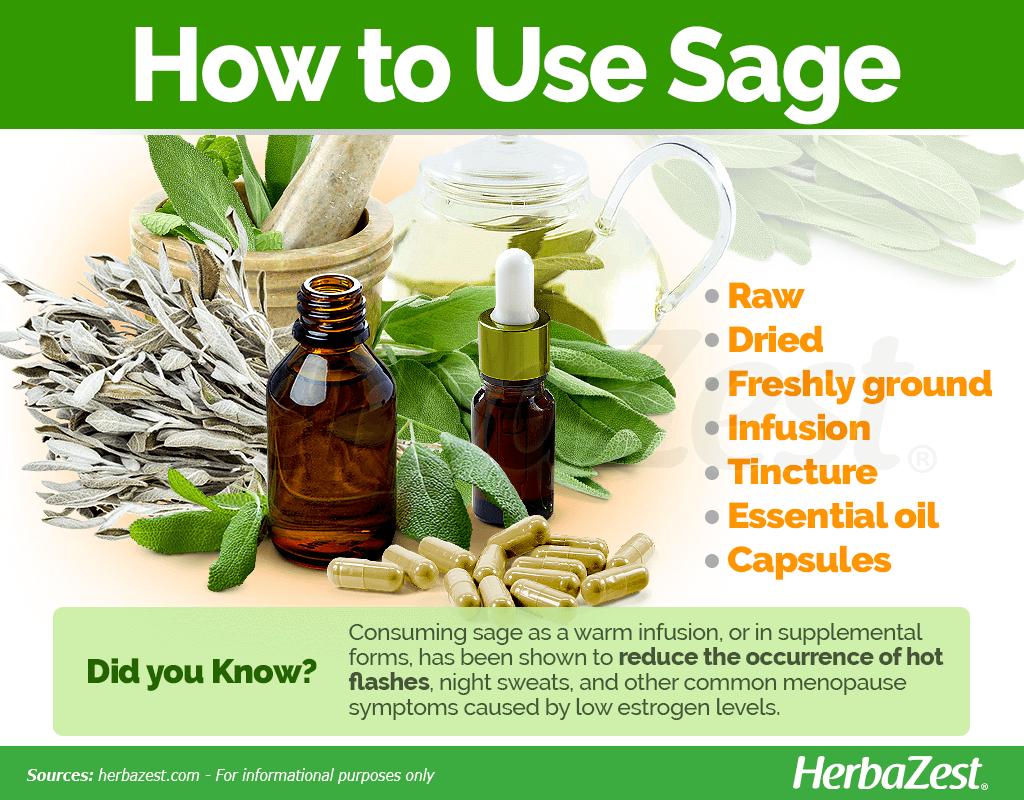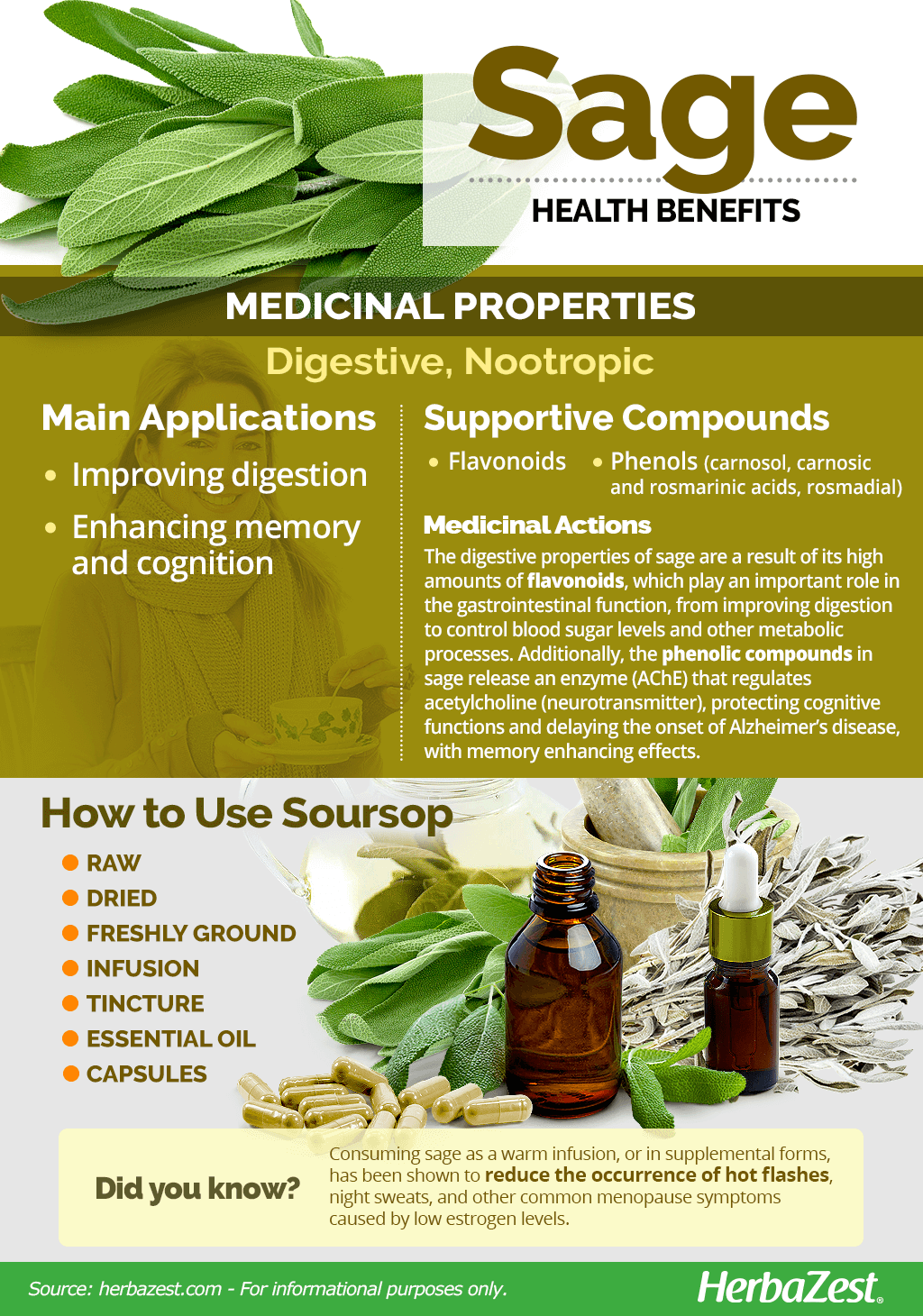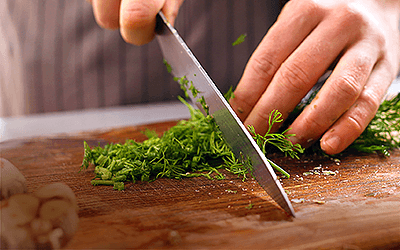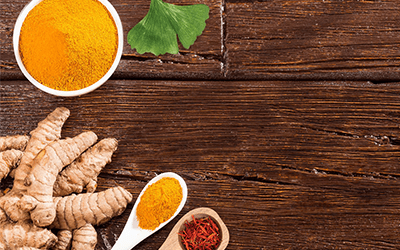A favorite among chefs and herbalists, sage, also known as common sage, culinary sage, and garden sage, has been a staple herb for centuries in many parts of the world. This perennial shrub is valued for its flavor along with its nutritional and medicinal purposes. It is often associated with hearty holiday meals, such as Thanksgiving in the United States. It is also a popular herb to grow in the garden or as a houseplant for reaping its benefits all year long. Thanks to Italian, Balkan, and Middle Eastern cuisines, sage remains a popular ingredient to this day.
Sage Medicinal Properties
Health Benefits of Sage
Studies have shown that a combination of active ingredients may produce the many health benefits of sage. Sage, commonn sage, clunianry sage, or garden sage, has historically been praised as a medicinal herb, owing to the complicated interactions that occur between its different compounds in the human body. Throughout history, Eastern and Western medicinal traditions have taken advantage of the benefits of sage, mainly for:
Improving digestion. Sage has been tradicionally used to improve digestion and soothe gastrointestinal discomfort.
Enhancing memory and cognition. Additionally, scientific studies have discovered that sage can help with age-related memory loss and general brain functions, and it has been suggested that it may also reduce the effects of Alzheimer's.
Additionally, sage has been shown to be effective reducing night sweats and hot flashes, among other menopause symptoms.
How It Works
Sage properties hail from its high concentration of flavonoids and phenolic compounds, all of which exhibit strong antioxidant effects.
The digestive properties of sage are attributed to its flavonoids, which play a key role in gastrointestinal functions, protecting the integrity of the intestinal lining against toxins from food and pharmacological drugs, improving the quality of the microbiota, and stabilizing blood glucose as well as aiding lipids and energy metabolism. All these actions not only allows for a healthy digestive process but also contribute to reduce the risk of cardiovascular and metabolic diseases.1,2
Sage is among the most popular herbs for treating dyspepsia in folk medicine.
On the other hand, carnosol, carnosic and rosmarinic acids, and rosmadial, the main phenolic compounds of sage, work together to stimulate the antioxidant defense systems, which help improve cognitive performance. When taken as a tincture, sage releases acetylcholinesterase (AChE),an enzyme that inhibits the chemical messenger acetylcholine. By maintaining acetylcholinesterase levels in the brain, sage can lessen the degeneration of mental capacities and may potentially delay the onset of Alzheimer's disease.3,4
On the other hand, sage has been shown effective in the treatment of hot flashes, a common menopause symptom. It is thought that the active compounds of the herb are able to regulate the neurotransmitters affected by estrogen deprivation.5
Digestive properties are also present in herbs like cardamom, cinnamon, and oregano, whereas saffron and ginkgo help prevent cognitive decline.
Sage Side Effects
Sage leaves, fresh or dried, are considered safe in culinary amounts. While more research needs to be conducted in order to determine the potential side effects of sage in medicinal preparations, it is likely safe for those who do not take it orally or use it topically in the long term. However, sage contains thujone, which in large doses can lead to seizures, as well as damage to the liver and nervous system.
Sage oil and leaves are likely safe when applied topically. However, skin irritation can occur in sensitive people.
Cautions
Because common sage can potentially lower blood pressure levels, it is recommended that those with hypotension or taking blood pressure medicine limit their intake of the herb.
Those who regularly suffer from seizures should also exercise caution when consuming sage due to its thujone content, which can worsen this condition.
Because of its thujone levels, women who are pregnant or breastfeeding should practice caution when consuming sage. Thujone can trigger a menstrual cycle, which can lead to a miscarriage in some instances. For mothers who are breastfeeding, thujone can reduce the milk supply.
- Medicinal action Digestive, Nootropic
- Key constituents flavonoids, phenolic compounds
- Ways to use Capsules, Hot infusions/tisanes, Food, Tincture, Essential oil, Dried
- Medicinal rating (3) Reasonably useful plant
- Safety ranking Use with caution
How to Consume Sage
The most effective way of obtaining the health benefits of sage is in medicinal forms of consumption, where its properties are more concentrated.
Natural Forms
Raw. While sage leaves are rarely consumed raw, they are occasionally used as a garnish for many dishes. While more research needs to be conducted to better understand why, some studies have suggested that consuming raw sage leaves an help improve memory and other mental functions.
Freshly ground. A popular spice in the kitchen, sage leaves are used to flavor many different dishes. It adds a savory, peppery dimension to dishes, so sage is typically added near the end of the cooking process. Freshly ground sage eases many stomach ailments, including diarrhea or upset stomach.
Infusion. Preparing a warm infusion using fresh or dried sage leaves can provide a number of medicinal benefits. Sage tea offers high levels of antioxidants, which slow down the aging process by preventing memory loss and general cognitive decline.
Herbal Remedies & Supplements
Tincture. When sage leaves are macerated in a neutral alcohol a concentrated preparation is obtained. By diluting few drops in a glass of water, sage tincture can help with cognitive functions and reduce perspiration, which can ease night sweats. These effects can last for several days.
Essential oil. The essential oil obtained from sage leaves facilitates digestion and inhibits the microbial growth that interferes with a proper digestion.
Capsules. When taken as a capsule, sage can improve cognitive functions, such as memory. This is due to its cholinergic properties.
- Edible parts Leaves
- Edible uses Flavoring
- Taste Aromatic, Mildly bitter, Earthy

Growing
Popular in many herbal gardens, sage is a perennial evergreen that yields the best results when planted during early spring, when temperatures range from roughly 60 - 70°F (15 - 21°C).
Growing Guidelines
Though it is an evergreen shrub, environments that are regularly colder than 10°F (12°C) are inadvisable
Full sunlight and soil that drains well will create ideal conditions, though once fully established, the herb can withstand slightly harsher surroundings.
Late frosts can easily wipe out herbal seedlings, so it is recommended to transplant them once they've reached 18 - 24 inches (45 - 60 cm) in height.
Detailed information about growing sage can be found in the herb garden section.
- Life cycle Annual
- Harvested parts Leaves
- Light requirements Full sun
- Soil Loamy sand
- Soil pH 6.1 – 6.5 (Slightly acidic)
- Growing habitat Temperate climates, Mediterranean regions
- USDA Plant Hardiness Zones 5a, 5b, 6a, 6b, 7a, 7b, 8a, 8b, 9a, 9b
- Potential insect pests Mites
- Potential diseases Root rot
Additional Information
Plant Biology
Standing an average of two feet (60 cm) tall, sage is a perennial shrub typical of temperate climates and Mediterranean landscapes. From plant to plant, this shrub can vary in size, flower color, foliage pattern, and leaf type, but leaves tend to be oblong and grey-green while flowers are purple or blue.
Classification
Sage (Salvia officinalis) is a member of the Lamiaceae, or the mint family, along with over 7,200 species, including skullcap (Scutellaria lateriflora), rosemary (Rosmarinus officinalis), basil (Ocimun basilicum), lemon balm (Melissa officinalis), peppermint (Mentha piperita), and thyme (Thymus vulgaris).
Related species of Sage
The Salvia genus is present in different continents, from the Far East to Europe and the Americas, and comprises almost 1,000 species, being Salvia officinalis the most economically important. However, there are many other important Salvia species with medicinal and folk applications:
S. bowleyana (nan dan shen) and S. miltiorrbiza (dan shen) are both native to China.
S. coccinea (blood sage) grows across the Americas.
The seeds of S. columbariae or California sage (from western North America) and S. hispanica or chia, from Central America, are both used in the same way.
S. divinorum (salvia) only grows in Mexico and it is ritually used for its psycoactive properties.
S. viridis, also known as painted sage, is common in the Mediterranean basin.
S. lavandulaefolia (Spanish sage) is native to France and Spain, it lacks thujone (the toxic compund in S. officinalis) and it is also used to enhance cognitive function.
S. pomifera (Cretan sage) is restricted to Greece and parts of the Mediterranean.
S. sclarea (clary sage) and S. repens (creeping sage) are native from southeastern Africa.
Historical Information
Ancient Greeks are responsible for the first records of the use of sage, which is native to temperate Mediterranean climates. Original uses included the treatment of snakebites and increasing female fertility. Historians report the use of sage during the Roman Empire as a diuretic and anesthetic, but the plant continued on to greater fame in the Middle Ages, when it was incorporated into mixtures that were meant to prevent the plague, and its healing properties were widely renowned.
Economic Data
Many industries employ sage, its distilled essential oils, and other sage-derived products. Dried sage leaves can be found in the spice racks of many families' cupboards in the Western world, leading to an avid import business. Albania and Croatia are the traditional top suppliers of dried sage, and its annual trade is valued in approximately $5 million USD.
Furthermore, the distilled essential oil is used extensively for manufacturing perfumes, soaps, and cosmetics. The sage plant by itself and its seeds are a staple of gardening, and thus are frequently commercialized as well.
Popular Beliefs
For many Native American tribes, sage is considered a sacred herb because of its purifying energies and played a role in past and present ceremonies. Along with a mix of other herbs and berries, it was used in a Kinnikinic mixture. This mixture was smoked in a sacred pipe and offered to the Spirits.
Other Uses of Sage
Gardening. Those who like to garden may choose the herb for aesthetic pleasure, as the right conditions can let it grow large enough for a pretty ground cover of purple flowers.
Aromatherapy. Sage's aroma is considered soothing by many people, and it is traditionally associated with health, happiness, and good tidings. For this reason, the herb is incorporated into soaps, perfumes, and other beauty products.
- Other uses Cosmetics
Sources
- British Journal of Pharmacology, Flavonoids: some of the wisdom of sage?, 2004
- Calflora, Chia sage
- Cochrane Database of Systematic Reviews, Herbal (non‐Chinese) medicines for functional dyspepsia, 2019
- Journal of Traditional and Complementary Medicine, Chemistry, Pharmacology, and Medicinal Property of Sage (Salvia) to Prevent and Cure Illnesses such as Obesity, Diabetes, Depression, Dementia, Lupus, Autism, Heart Disease, and Cancer, 2014
- Molecular Targets and Therapeutic Uses of Spices, p. 342
- Sage: The Genus Salvia
- USDA Plants Database, The spice market in the United States: 1995 Annual Report
- Encyclopedia of Herbal Medicine, pp. 130-1
- NCCAM Herbs at a Glance, Sage: Science and Safety
- Medicinal Plants of the World, pp. 283-4
- Journal of Ethnopharmacology, Ethnopharmacological in vitro studies on Austria's folk medicine-An unexplored lore in vitro anti-inflammatory activities of 71 Austrian traditional herbal drugs, 2013
Footnotes:
- Molecular Aspects of Medicine. (2018). Flavonoids and the gastrointestinal tract: Local and systemic effects. Retrieved February 27, 2023, from: https://pubmed.ncbi.nlm.nih.gov/29317252/
- Journal of Ethnopharmacology. (2010). Activation of the nuclear receptor PPARγ by metabolites isolated from sage (Salvia officinalis L.). Retrieved February 27, 2023, from: https://www.sciencedirect.com/science/article/abs/pii/S0378874110005489
- Nutrients. (2021). The Acute and Chronic Cognitive Effects of a Sage Extract: A Randomized, Placebo Controlled Study in Healthy Humans. Retrieved February 27, 2023, from: https://www.ncbi.nlm.nih.gov/pmc/articles/PMC7828691/
- Journal of Clinical Pharmacy and Therapeutics. (2003). Salvia officinalis extract in the treatment of patients with mild to moderate Alzheimer's disease: a double blind, randomized and placebo-controlled trial. Retrieved February 27, 2023, from: https://pubmed.ncbi.nlm.nih.gov/12605619/
- International Journal of Reproductive BioMedicine. (2019). The effect of Saliva officinalis extract on the menopausal symptoms in postmenopausal women: An RCT. Retrieved February 27, 2023, from: https://www.ncbi.nlm.nih.gov/pmc/articles/PMC6686654/











